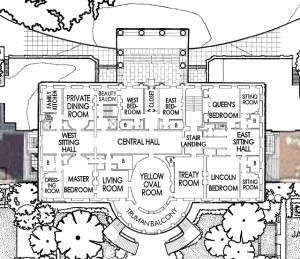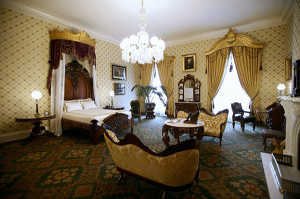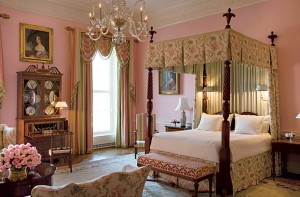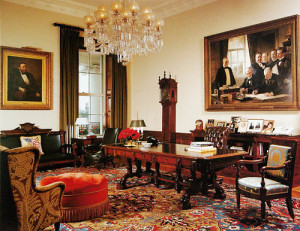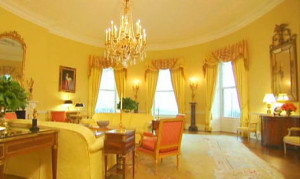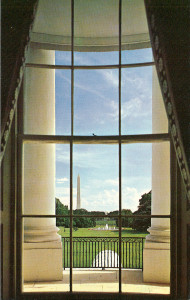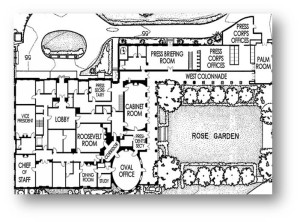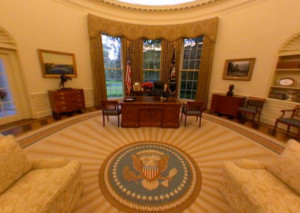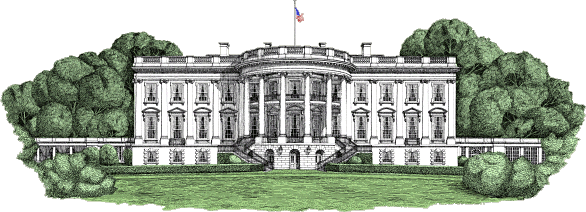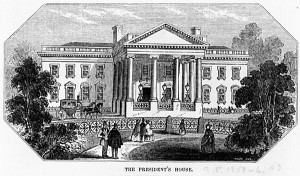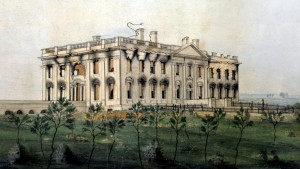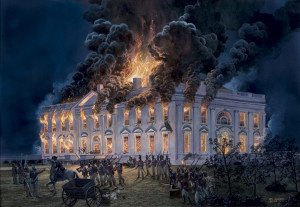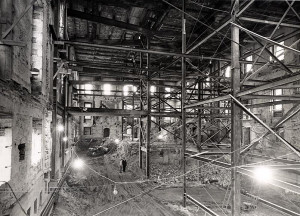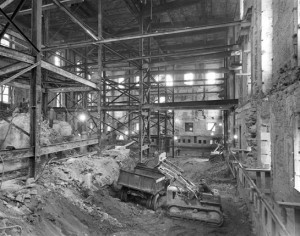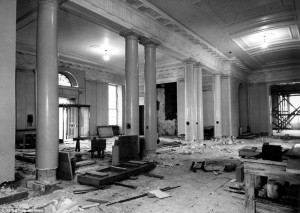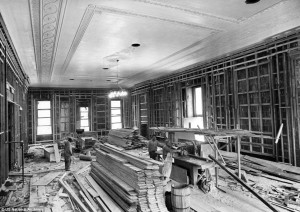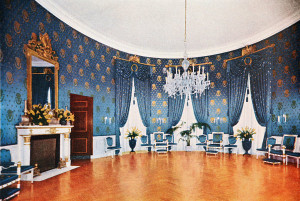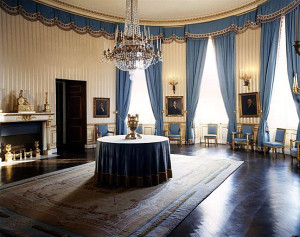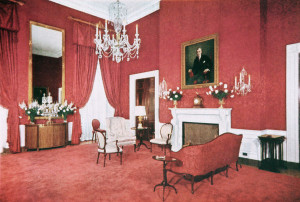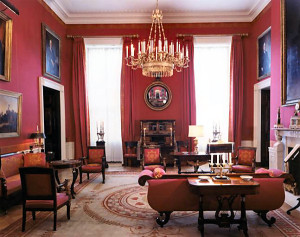Previously, in Part One of the three part series on the White House I discussed the history and the construction of the White House. Part Two gave a tour of the various rooms of the State Floor of the White Floor, such as the East Room and Blue Room. In this post I will give a tour of some of the rooms on the second floor of the White House where the famous Lincoln Bedroom is located and the West Wing which is where the Oval Office is located.
Throughout the years constant changes have been made to both the interior and exterior of the White House. One of the most significant changes to the White House was in 1902 when an addition was built to accommodate separate offices for the President and his staff. The three story building known as the West Wing is located adjacent to the White House and this directly caused a significant change to lives of the President within the White House. By moving the presidential offices outside the main building it allowed the second floor of the White House to become the private residence of the President and his family during their term in office. Some of the rooms on the second floor of the White House are also maintained for their historical importance, such as the famous Lincoln Bedroom.
So, let’s get started on a tour of the second floor of the White House.
Second floor of the White House
As previously mentioned, the second floor of the White House is the private residence of the President and his family. There are a total of 16 rooms on the second floor and must be accessed from a long main corridor. There are several private bedrooms for the President and his family, several guest bedrooms with adjacent sitting rooms and there are 6 bathrooms, a large reception room, a more private living room and a small private dining room with an adjacent kitchen. In general most of the rooms on the second floor are very large with 12 foot ceilings. Each presidential family has made renovations or have redecorated the second floor of the White House to reflect their personal style. Usually the President and his family will also bring personal items from their private homes to create an environment that is comfortable for them.
Lincoln Bedroom –
One of the most famous rooms on the second floor of the White House is the Lincoln Bedroom. President Abraham Lincoln did not use this room as a bedroom but as an office. The bedroom that Lincoln actually used during his time in the White House was previously located on the northwest side of the second floor but during the extensive Truman reconstruction of the White House the room was converted into the current Private Dining Room and Family Kitchen.
During the time that Lincoln used the room as an office the walls had dark green wallpaper and there was a dark green carpet on the floor. Hung on the walls of the room were various maps that were used to plan military strategy during the Civil War and newspapers, documents and mail were piled on the desk and tables. The room holds great historical significance because it was used when President Lincoln signed the Emancipation Proclamation on January 1, 1893.
The Lincoln Bedroom and adjacent sitting room are decorated in a Victorian style. The main feature is the large bed is made of rosewood which measures eight feet by six feet and has an elaborate carved headboard which is currently displayed with a reproduction of the original decorative bed canopy. The bed was believed to have been purchased by First Lady Mary Todd Lincoln but unfortunately there is no documented proof that President Lincoln actually used the bed. The Lincoln bedroom is furnished with two sofas and three matching chairs but the most notable item in the room is the holograph copy of the Gettysburg Address that is on display on the desk, it is one of five copies that are signed by Lincoln.
Like many rooms in the White House, the Lincoln Bedroom has renovated several times by recent administrations but always in the distinctive Victorian style. Currently the wallpaper on the walls is a cream colored diamond pattern and the lace, silk and velvet drapes used with the bed canopy were inspired by 19th century photographs. A gilded window valance in a Rococo Revival style compliments the bed canopy and new gold draperies were also installed at the windows.
Queen’s Bedroom –
The Queen’s Bedroom is located across the hall from the Lincoln Bedroom on the second floor of the White House. The room received its name from the various royal guests, such as Queen Elizabeth II, that have stayed in the room. In prior administrations the room was used as a bedroom for private secretaries and the children of the President, the room was previously known as the Rose Room. Currently the Queen’s Bedroom is furnished in the Federal style with a bed that once belonged to President Andrew Jackson.
Treaty Room –
The Treaty Room is located next to the Lincoln Bedroom and is traditionally used as a private study for the President. The room has been the setting for several historical events, such as the signing of the peace treaty to end the Spanish-American War on August 12, 1898 by President McKinley, in 1963 President Kennedy signed the Nuclear Test Ban Treaty and on October 7, 2001 President Bush addressed the nation to announce the start of the Afghanistan War.
Currently the walls of the Treaty Room are painted an off-white color and the room is decorated with olive green velvet draperies and a Victorian crystal chandelier. Until recently a large oil painting called “The Peacemakers” by George Healy hung in the Treaty Room, it depicted a meeting in 1865 during the Civil War between President Lincoln, General Ulysses Grant and General Sherman. The painting was moved during the Obama administration to the Private Dining Room down the hall from the Treaty Room.
Yellow Oval Room –
The Yellow Oval Room is located in the center of the second floor of the White House and has three large windows and a door that leads to the Truman Balcony. A set of double doors lead into the President’s private bedroom suite. During past administrations the room has been used as a library, office and parlor. In recent years the room has been used for smaller intimate receptions and primarily for greeting visiting heads of state before proceeding down to the State Dinner.
Here are some interesting facts about the Yellow Oval Room – First Lady Dolley Madison was the first to decorate the room in yellow damask. During the Harrison administration the first White House Christmas tree was placed in the room. President Roosevelt was in the room when he learned about the Pearl Harbor attack. After the Kennedy renovation of the White House the room was officially designated as the Yellow Oval Room.
The Yellow Oval Room is frequently redecorated by the presidential family but throughout the years the room’s main color scheme has remained various shades of yellow. The furnishings are in the Louis XVI style with two comfortable sofas, several armchairs, a large Empire chandelier and a collection of antiques.
Truman Balcony –
The Truman Balcony is a relatively new feature to the White House and it completed in 1948 during the Truman administration. (hence the name!) When the balcony was proposed the intent was to provide shade to the South Portico and eliminate the awnings that President Truman felt were an eyesore. The critics felt that the columns required to support the balcony would compromise the architectural style of the White House. When the balcony was finished the critics changed their minds and felt that it actually improved the appearance of the south side of the White House. Since the 1950s every President and his family have enjoyed the privacy of the balcony and it is used frequently for small informal gatherings.
West Wing
The West Wing is a three story Executive Office Building which is part of the White House Complex. The West Wing contains the Oval Office of the President of the United States, the Cabinet Room and the Situation Room and the offices of the presidential staff. The Press Briefing Room is adjacent to both the West Wing and the White White.
When the White House was first built in 1800 the President and his staff worked on the second floor. During the Roosevelt administration, the presidential staff had grown so large that the rooms in the White House proved to be insufficient. In 1902, the first West Wing was built on the grounds of the White House where the greenhouse and stables were formerly located. In 1909, during the Taft administration, the West Wing was enlarged and took over the area of the tennis court. At that time the first Oval Office was built in the center section of the new addition and was designed to duplicate the shape of the oval rooms of the White House. In 1929, the next addition added a basement to the West Wing but unfortunately that same year an electrical fire severely damaged the building. During the Franklin Roosevelt administration the West Wing was completely redesigned in 1933, more office space, a new Cabinet Room and the Oval Office was move to a different location in the building to allow for more privacy for the President. Since this final renovation the Eisenhower Executive Office Building took over the space of the former State and War Department Buildings.
Special Note: In the Roosevelt Room located in the West Wing there is a tradition that when a Democratic President is in office the portrait of Franklin Roosevelt hangs over the mantel and when a Republican President is in office the portrait is replaced by one of Theodore Roosevelt.
During the Franklin Roosevelt administration a swimming pool was built so that President Roosevelt could exercise as therapy for his disability related to polio, President Kennedy also used the pool several times a day to relieve the pain in his back. During the Nixon administration, the swimming pool was covered over permanently and a new Press Briefing Room was built in its place and it is where the White House Press Secretary gives a daily briefings.
Oval Office –
The Oval Office is located in the West Wing and it is the official office of the President of the United States. The room dimensions are approximately 35 feet by 29 feet and the ceiling height is 18 feet. There are three large windows on the south side and on the north side there is a fireplace. The east door opens out to the Rose Garden, the west door into a private study, another door opens to the office of the President’s secretary and the last door opens directly into the main hallway of the West Wing.
The tradition of the shape of the Oval Office dates back to when George Washington was first elected and he moved into the President’s House in Philadelphia. He immediately requested that the straight rear wall of the reception room be rebuilt in a semi-circular shape to create a more hospitable room for entertaining. When the federal government moved to Washington D.C. and the White House was specifically designed to incorporate an oval-shaped room. There are actually several oval shaped rooms in the White House, the Blue Room on the State floor which was used for receptions and the Yellow Oval Room on the second floor. When the West Wing was renovated in 1909 the Oval Office was built as the President’s office to replicate the shaped of the ones in the White House.
Every President will traditionally have the Oval Office redecorated at the start of their administration and will select the furniture, drapes and carpet to suit their needs and personal decorating style. The President will also have access to a wide selection of historical artwork and decorative items they can select from the White House collection or can be loaned from museums.
In general, the room is usually furnished with two sofas, several chairs, a coffee table and side tables with lamps. One of the main features of the room is the Presidential Seal ceiling medallion and the room is lite by light bulbs hidden within the cornice surrounding the room giving the ceiling a wonderful glow. Another feature that bears the Presidential seal is the oval carpet used in the room. President Truman had the first one made for the Oval Office and it was used by both President Eisenhower and President Kennedy. Recently, most incoming Presidents will have their own carpet made to their specifications and when they leave office it will eventually be installed in their presidential libraries.
Another item that an incoming President will select is the desk that they will use in the Oval Office. There have been six different desks used throughout the years but the one used most frequently is the famous Resolute Desk. The British frigate, HMS Resolute, had become stuck in the frozen ice of the Arctic and it was abandoned. After it was recovered by an American seaman, it was refurbished and presented as a gift from the United States to Queen Victoria in 1856. It remained in service by the British Navy until 1879. After it was decommissioned, Queen Victoria ordered two matching desks made from the wood of the frigate. The Queen kept one for her use at Buckingham Palace and the other was given to President Rutherford Hayes in 1880. When President Franklin Roosevelt used the deck he ordered a panel carved with the Presidential Seal to make the fact that he was in a wheelchair less noticeable. Of course, there is a famous photo of John Kennedy Jr. peeking through the panel when he visited his father, President Kennedy, in the Oval Office.
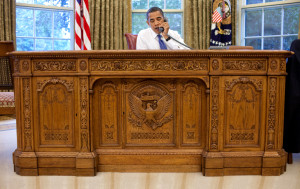

Here are some historical events that have been televised from the Oval Office – In 1962, President Kennedy addressed the nation about the Cuban Missile Crisis. In 1974, President Nixon announced his resignation. In 1986, President Reagan addressed the nation following the Space Shuttle Challenger Disaster. In 2001, President George W. Bush spoke to the nation on the evening of September 11.
This concludes the tour of the White House. For more information please click on the other two posts of the three part series on the White House. In Part One of the series I discussed the history and the construction of the White House. Part Two gives a tour of the various rooms of the State Floor of the White Floor, such as the East Room and Blue Room.
White House Trivia
- The White House has 6 different floors, the Ground Floor, the State Floor, the Second Floor (which is the President’s private residence), the Three Floor and two basement levels.
- The White House has 132 rooms, 35 bathrooms. There are 412 doors, 147 windows, 28 fireplaces, 8 staircases and 3 elevators.
- It takes 570 gallons of “Whisper White” Duron paint to cover the exterior of the White House.
- George Washington might have slept in a lot of different places when he toured the country after being elected the first President of the United States but he is the only president to have never slept in the White House.
- The White House was the largest house in the United States until after the Civil War.
- The White House has been known by many names, such as the President’s House and Executive Mansion. It officially became known as the White House during the Theodore Roosevelt administration and all official government correspondence started to use the name.
- The White House first had interior running water in 1833, a central heating system was installed in 1837 and electricity was first installed in 1891.
- The White House Complex covers 18 acres and a crew of 13 full-time staff maintains the grounds and the gardens.
- The White House was designated a National Landmark in 1960.
- The famous portrait of George Washington by Gilbert Stuart is the oldest furnishing in the White House
- The White House appears on the back of the $20 bill.
(For information about the two additional presidential landmarks located in Washington, D.C. which were featured this month, please click on the links to the Lincoln Memorial and the Washington Monument)

